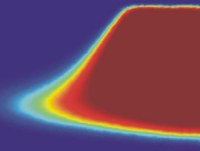THEORETICAL MODELLING
Finite Difference Time Domain (FDTD) codes are used to model how electromagnetic fields affect both magnetic and non-magnetic materials. Alternatively, the electrothermal processes that occur in probe storage devices, based on phase-change materials, can be modelled.
Computer codes based on Fresnel and conformal mapping theory allow modelling of the optical response of planar and diffraction grating multi-layer systems. By comparison with data acquired via experiment, the director profile through a liquid crystal cell, the groove profile of a diffraction grating, electromagnetic field profiles through a multi-layered structure or the optical permittivities and thickness of a metal or dielectric film (for example) may be determined.
Finite element modelling codes allow the optical and microwave response of complex diffractive structures to be predicted.
Modelling codes allow simulation of magnetization dynamics within both single isolated elements and arrays of particles with the predicted response of a system being displayed as the spatial distribution of the magnetic field magnitude. |




